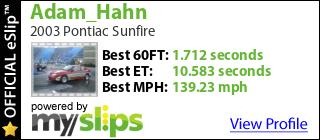Whats the deal with inline fuel pumps? When there installed do you have to pull the relay for the stock one and the inline one will do all the work or do you still have the stock pump on and the inline one on?
http://www.cardomain.com/ride/2090440

the inline is just a "helper" pump...
but takes a LOT of stress off your stock one so you wont have to worry about over working your stock fuel pump
 LE61T PTE6262 Powered
LE61T PTE6262 Powered 
But how does take stress off?
Would it not starve the stock pump and over stress?
Am I thinking of it wrong?
instead of the stock pump being over worked, it will just instead kind of "idle" while the inline pump sucks all of the fuel past the stock pump. kind of like what the idea of twin charging (supercharger and turbo). the supercharger powers till the turbo spools, then just idles as the turbo takes over and does the work.

Would that only work if the stock pump is passive, or it would have to be pumped from both?
The inline pump relieves stress from the stock pump because with the inline, the stock pump only has to push fuel through a foot or two of line (as opposed to 10+ feet ) to the inline pump. Because the inline is much stronger, it can force the fuel through the longer line to the motor much easier. The stock pump is never passive because as far as the stock ECU knows, there is no inline pump.

Street-Legal 2003 Sunfire 10.58 @ 139 MPH
What happens to the fuel pressure if the inline pump dies?
Does the inline become passive when it dies/breaks/shutdown/whatever or does fuel stop flowing causing the stock pump trying to push fuel and braking a line or a pump?
Fuel pressure only exists when there's a restriction to flow. When inline pumps fail they usually present some restriction to the in tank pump. Sometimes you can drive the car easily and it will run moderately well. Sometimes the engine will only idle. Sometimes it won't even start. It all depends on whether the inline pump has internal checkvalves, what type of pump is it, how tight the clearances are, and how strong the in tank pump is.
As far as twin pump systems, the idea is fairly simple. Most pumps have a large variation between how much fuel they can deliver at low pressure and how much they can deliver at high pressure. On of the arguments for the Walbro in tank pumps is that the total volume of fuel delivered doesn't drop as much as a stock pump when pressure requirements increase. When you add an inline pump you're really doing two things. 1) You're allowing the stock in tank pump to move a higher volume of fuel by reducing the pressure requirement at the pump, and 2) You're using the in tank pump as a "lift pump" supplying low pressure fuel to an inline pump which is capable of generating high fuel pressure and volume at the pump outlet but which does a poor job of "sucking" fuel out of a fuel tank.
With this system you won't gain anything if the fuel demands at the injectors are greater than the volume of fuel which can be supplied by the in tank pump. If you can't move enough fuel to the inline pump then it won't supply enough fuel to the injectors. A weak, old, or tired in tank pump can cripple even the best inline pump.
Some things to consider imo: 1) Voltage to both pumps should be at the maximum possible. This is always true even with single pump systems, but it's more important with a dual pump because some people tap into the OE pump power wire to run the second pump. This reduces voltage to both pumps. 2) More pumps mean more areas to look when troubleshooting a fuel delivery issue. With in tank pumps which can supply enough fuel, there aren't as many reasons to go with an inline pump. 3) A failed pump in a twin pump system can be worse than a failed single pump. When a single pump dies the engine doesn't run. When one of 2 pumps fails the engine can run lean which can cause damage. And when the in tank pump fails and the inline pump is spinning away with no fuel to lubricate or cool the internal parts, you are reducing the life of your inline. 4) If you decide to use an inline, Volkswagen and Saab reliably used twin pump systems for many years. Saab turbo cars often use a pump whos specs match some of the highest flowing inline pumps. For some reason the Saab pump is much less expensive than a name brand "high performance" pump.
hth
-->Slow




